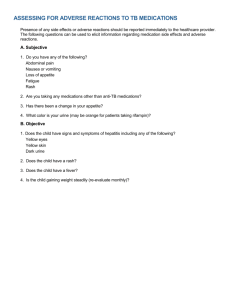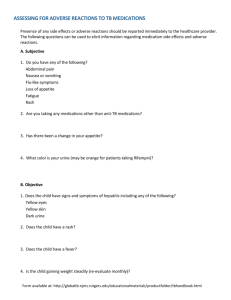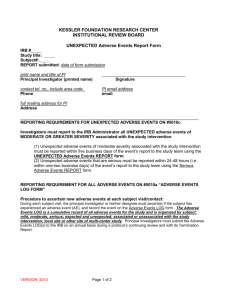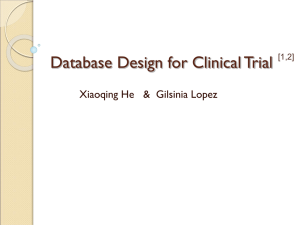Unexpected Adverse Events Guidelines (WORD 26.1KB)
advertisement
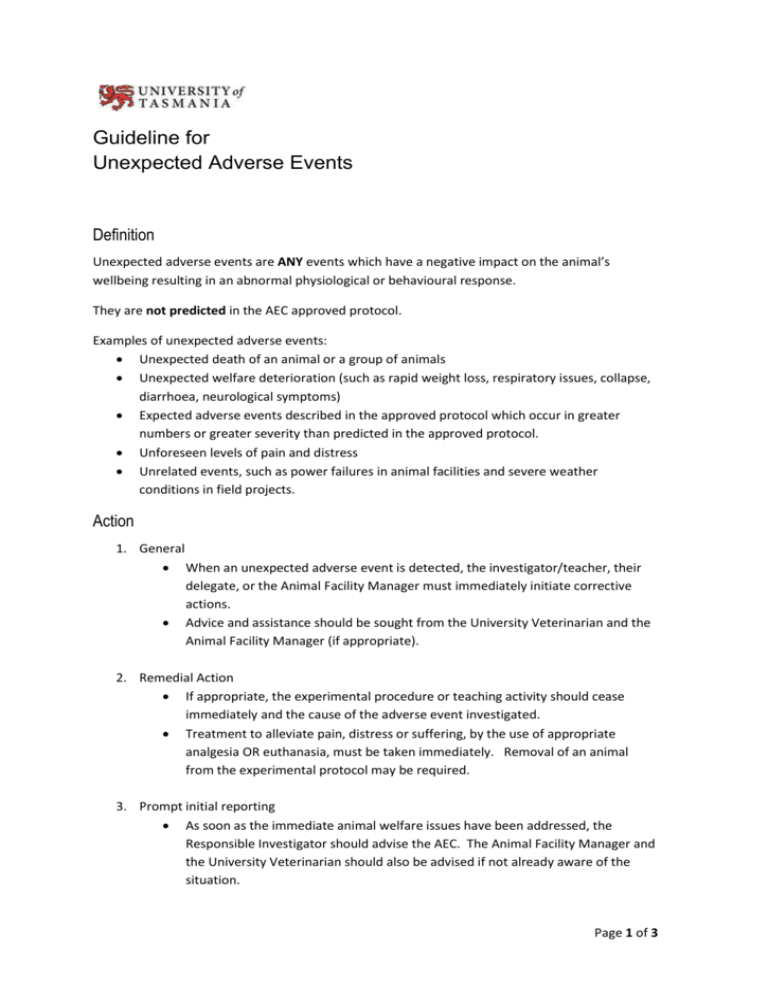
Guideline for Unexpected Adverse Events Definition Unexpected adverse events are ANY events which have a negative impact on the animal’s wellbeing resulting in an abnormal physiological or behavioural response. They are not predicted in the AEC approved protocol. Examples of unexpected adverse events: Unexpected death of an animal or a group of animals Unexpected welfare deterioration (such as rapid weight loss, respiratory issues, collapse, diarrhoea, neurological symptoms) Expected adverse events described in the approved protocol which occur in greater numbers or greater severity than predicted in the approved protocol. Unforeseen levels of pain and distress Unrelated events, such as power failures in animal facilities and severe weather conditions in field projects. Action 1. General When an unexpected adverse event is detected, the investigator/teacher, their delegate, or the Animal Facility Manager must immediately initiate corrective actions. Advice and assistance should be sought from the University Veterinarian and the Animal Facility Manager (if appropriate). 2. Remedial Action If appropriate, the experimental procedure or teaching activity should cease immediately and the cause of the adverse event investigated. Treatment to alleviate pain, distress or suffering, by the use of appropriate analgesia OR euthanasia, must be taken immediately. Removal of an animal from the experimental protocol may be required. 3. Prompt initial reporting As soon as the immediate animal welfare issues have been addressed, the Responsible Investigator should advise the AEC. The Animal Facility Manager and the University Veterinarian should also be advised if not already aware of the situation. Page 1 of 3 Action must be taken to ensure other animals have not and will not be impacted on in this project or any related project prior to continuing with the approved protocol. If other animals are likely to be impacted, the Investigator should consult with the AEC Chair and Executive to clearly determine which areas of work are suspended pending finalisation and review of the Adverse Event. 4. Responsibility for Reporting to the AEC. Prompt reporting of an adverse event to the AEC is a requirement of the Code of practice (section 2.2.28) The investigator or teacher has primary responsibility for reporting an adverse event. However, the Animal Facility Manager may report non experimental adverse events such as colony management issues or facility equipment failure. 5. Investigation and Preparation of an Unexpected Adverse Event Report A rigorous investigation into the cause or factors contributing to the adverse event must occur in order to prepare a full report to the AEC and recommendation to prevent future recurrence. If an animal has died unexpectedly, an autopsy must be performed if the carcase is not decomposed. Autopsies can be performed with the assistance of the University Veterinarian or by other competent personnel or external authorities. Samples should be taken for from animals requiring immediate euthanasia and submitted to a pathology lab for disease investigation if the cause of the adverse event is not clearly determined during initial stages of the investigation. These samples could include blood for serological disease testing or fresh and/or preserved tissue samples. Full details of the unexpected adverse event should be gathered from all involved parties which may include animal care staff as well as the research team. If a full report cannot be provided immediately an interim report should be submitted to the AEC. The adverse event report should contain the following information: A brief summary of the methodology of the approved project including the total number of animals approved. Brief Details of any previous adverse unexpected adverse events in the project. Concise history or description of events including location, date, time of event and a summary of initial actions taken. Numbers of animals affected by the unexpected adverse event and details of the welfare impact (mortality and morbidity). Details of personnel present and/or involved. Identification of known or likely causal factors. Autopsy or pathology test results. Proposed changes or actions to prevent a recurrence. 6. AEC review of an unexpected adverse event Page 2 of 3 The AEC must review the unexpected adverse event to identify the causal and contributing factors – such as disease, equipment failure, poorly maintained facilities, experimental procedures, poor experimental technique impact on the animal and determine whether factors have been adequately dealt with by the investigator or teacher. The AEC may resolve to make recommendations to the institution to resolve matters if the causal factors cannot be resolved by the Investigator or teacher. The AEC must also manage any non-compliance. The AEC should also determine whether there was sufficient information provided in the original application and the likelihood that the event could be repeated. Decide on an appropriate course of action: Warnings or formal discipline, suspension of project, change in experimental protocol, withdrawal of project approval Directions for training, project monitoring by the University Veterinarian or inspections by AEC. Improvements in facilities, staffing, equipment Reporting the matter to the Regulator Unexpected Adverse Events should also be recorded in the project file and reported by the Investigator in Annual and Final project reports. CHECKLIST Unexpected adverse events are not predicted in the approved protocol and have a negative impact on the animal’s wellbeing These events must be reported promptly to the Animal Ethics Committee, the University Veterinarian and if relevant to the Animal Facility Manager by email by the next working day. A full report should be submitted after the investigation is complete. Even if the event has nothing to do with the experimental procedure, it must be reported as an adverse event. A full investigation into the event is required. Whenever possible, an autopsy should be performed. Please place the animal in the fridge (not the freezer) while awaiting advice from the University Veterinarian. Seek advice – from the University Veterinarian, Ethics Office or the Animal Facility Manager. If you know an unexpected adverse event may occur in your experimental procedure such as an anaesthetic death or a wound breakdown in surgery, then you must predict this outcome in your AEC application when describing the procedural detail. The prediction should also include the expected frequency of occurrence. Page 3 of 3



